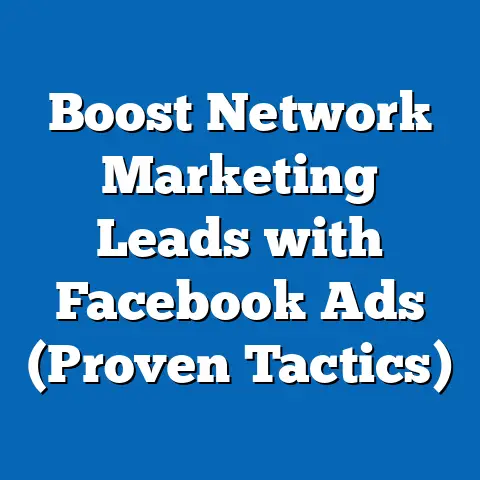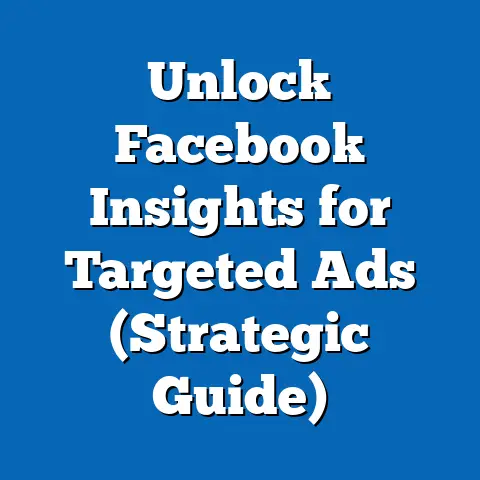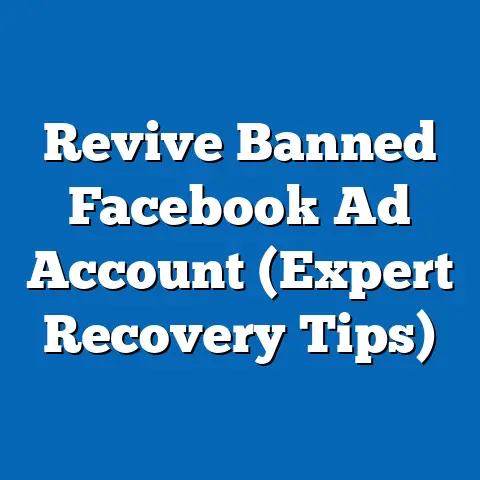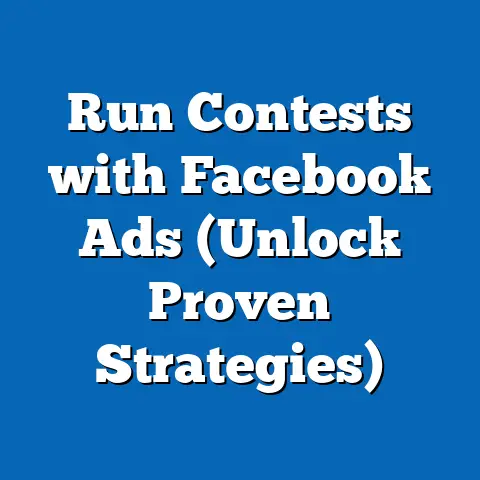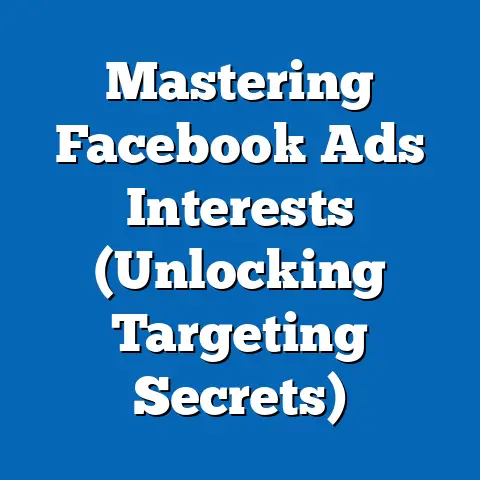Unlocking Hidden Behaviors in Facebook Ads (Pro Tips)
Let’s face it, Facebook advertising can feel like navigating a constantly shifting maze. One day you’re crushing it, the next your ads are underperforming, and you’re left scratching your head. It’s not enough to just throw money at the platform; you need to understand the subtle nuances, the hidden behaviors, that drive real results. I’ve spent years immersed in the world of Facebook ads, managing campaigns for everyone from small startups to established brands. I’ve seen firsthand what works, what doesn’t, and how to adapt when Facebook inevitably throws a curveball.
Warning: Before diving into the world of Facebook ads, it’s crucial to recognize that the platform is constantly evolving. What worked yesterday might not work today, and failing to adapt can lead to wasted budgets and missed opportunities. In this article, we will explore the often-overlooked behaviors of Facebook ads that can significantly enhance your ad performance if leveraged correctly. This isn’t just about the basics of setting up a campaign; it’s about understanding the why behind the what, and how to tap into the hidden potential of the platform.
1. Understanding the Facebook Ads Ecosystem
Before you can unlock hidden behaviors, you need a solid grasp of the fundamentals. The Facebook advertising ecosystem is vast, encompassing a range of ad formats, placements, and targeting options. It’s more than just boosting a post; it’s a complex system designed to connect businesses with their ideal customers.
Different Ad Formats and Placements
- Image Ads: The simplest format, ideal for showcasing a product or service with a compelling visual.
- Video Ads: Highly engaging, perfect for storytelling and demonstrating product features. I’ve found video ads consistently outperform image ads in terms of engagement and conversion rates, especially when targeting a younger demographic.
- Carousel Ads: Allow users to scroll through multiple images or videos, ideal for showcasing a range of products or highlighting different features.
- Collection Ads: Designed for mobile shopping, these ads feature a main image or video with a collection of related products below.
- Instant Experience Ads (formerly Canvas Ads): Full-screen, mobile-optimized experiences that load quickly and offer immersive content.
- Lead Ads: Collect leads directly within Facebook, simplifying the signup process for users.
- Messenger Ads: Reach users directly within the Messenger app, offering a personalized and interactive experience.
These ad formats can be placed across Facebook, Instagram, Audience Network, and Messenger. Understanding where your target audience spends their time is crucial for choosing the right placement. For instance, if you’re targeting a younger demographic, Instagram Stories might be a better choice than the Facebook News Feed.
The Facebook Algorithm: A Key to Success
The Facebook algorithm is the engine that drives content distribution on the platform. It determines which content users see based on a variety of factors, including:
- Affinity: How often a user interacts with a particular page or person.
- Weight: The type of content (video, image, link) and how engaging it is.
- Time Decay: How recently the content was posted.
Understanding how the algorithm works is crucial for getting your ads seen by the right people. Focus on creating high-quality, engaging content that resonates with your target audience. Encourage interaction by asking questions, running polls, and responding to comments. The more engagement your ads receive, the more likely they are to be shown to a wider audience.
Takeaway: Before you can unlock hidden behaviors, you need a solid understanding of the Facebook ads ecosystem. Experiment with different ad formats and placements to see what works best for your target audience. Focus on creating high-quality, engaging content that aligns with the Facebook algorithm.
2. The Importance of Audience Segmentation
Audience segmentation is the process of dividing your target audience into smaller, more specific groups based on shared characteristics. This allows you to tailor your ad messaging and creative to resonate with each group, leading to higher engagement and conversion rates.
Using Facebook’s Audience Insights Tool
Facebook’s Audience Insights tool provides valuable data about your target audience, including demographics, interests, behaviors, and purchase habits. This information can be used to refine your targeting and create more effective ad campaigns.
To access Audience Insights, go to Ads Manager and select “Audience Insights” from the “Tools” menu. You can then choose to analyze everyone on Facebook or people connected to your page.
I use this tool all the time to get a deeper understanding of my target audience. For example, if I’m advertising a fitness product, I might use Audience Insights to identify specific interests related to fitness, such as yoga, running, or weightlifting. I can then use this information to create targeted ad campaigns that resonate with each group.
Custom Audiences and Lookalike Audiences
- Custom Audiences: Allow you to target people who have already interacted with your business, such as website visitors, email subscribers, or customers. This is a powerful way to retarget users who are already familiar with your brand and more likely to convert.
- Lookalike Audiences: Allow you to reach new people who are similar to your existing customers. This is a great way to expand your reach and find new customers who are likely to be interested in your products or services.
Creating custom audiences and lookalike audiences is relatively straightforward. Simply go to Ads Manager and select “Audiences” from the “Tools” menu. You can then create a custom audience based on a variety of sources, such as your website, customer list, or Facebook page. Once you’ve created a custom audience, you can use it to create a lookalike audience based on the characteristics of your existing customers.
Takeaway: Audience segmentation is crucial for unlocking hidden behaviors. Use Facebook’s Audience Insights tool to refine your targeting and create more effective ad campaigns. Leverage custom audiences and lookalike audiences to reach users who are already familiar with your brand or similar to your existing customers.
3. Analyzing Ad Performance Metrics
Tracking and analyzing your ad performance metrics is essential for understanding what’s working and what’s not. This data can be used to optimize your campaigns and improve your ROI.
Key Performance Indicators (KPIs)
- Click-Through Rate (CTR): The percentage of people who see your ad and click on it. A high CTR indicates that your ad is relevant and engaging.
- Conversion Rate: The percentage of people who click on your ad and complete a desired action, such as making a purchase or filling out a form. A high conversion rate indicates that your landing page is effective and your offer is compelling.
- Cost Per Acquisition (CPA): The cost of acquiring a new customer through your ad campaign. A low CPA indicates that your campaign is efficient and cost-effective.
- Return on Ad Spend (ROAS): The amount of revenue generated for every dollar spent on advertising. A high ROAS indicates that your campaign is profitable.
These are just a few of the many KPIs that you can track in Facebook Ads Manager. The specific KPIs that you focus on will depend on your business goals.
Facebook’s Analytics Tools
Facebook Ads Manager provides a wealth of data about your ad performance, including impressions, reach, clicks, conversions, and cost. You can use this data to identify trends and patterns, and to optimize your campaigns for better results.
Facebook Analytics is another powerful tool that can be used to track user behavior on your website and app. This data can be used to understand how users are interacting with your business and to identify areas for improvement.
A/B Testing: The Key to Optimization
A/B testing is the process of comparing two versions of an ad to see which one performs better. This is a powerful way to test different ad elements, such as headlines, images, and calls to action, and to identify which ones resonate best with your audience.
I always recommend A/B testing multiple variations of your ads. You might be surprised at what you discover. For example, I once ran an A/B test that compared two different headlines for the same ad. One headline was straightforward and informative, while the other was more creative and attention-grabbing. The creative headline outperformed the straightforward headline by a significant margin, resulting in a higher CTR and conversion rate.
Takeaway: Tracking and analyzing your ad performance metrics is essential for understanding what’s working and what’s not. Use Facebook’s analytics tools to identify trends and patterns, and use A/B testing to optimize your campaigns for better results.
4. Leveraging Facebook Pixel for Behavioral Insights
The Facebook Pixel is a small piece of code that you place on your website to track user behavior after they click on your ads. This data can be used to retarget users, optimize your ad campaigns, and measure your ROI.
Setting Up Facebook Pixel
Setting up Facebook Pixel is relatively straightforward. Simply go to Ads Manager and select “Pixels” from the “Tools” menu. You can then create a new pixel and install it on your website.
Once the pixel is installed, it will begin tracking user behavior, such as page views, add to carts, and purchases. This data can be used to create custom audiences and retarget users who have taken specific actions on your website.
Using Pixel Data for Retargeting
Retargeting is the process of showing ads to people who have already interacted with your business. This is a powerful way to re-engage users who are familiar with your brand and more likely to convert.
For example, if someone visits your website but doesn’t make a purchase, you can retarget them with ads that feature the products they viewed. This reminds them of your business and encourages them to come back and complete the purchase.
Optimizing Future Ad Campaigns
Pixel data can also be used to optimize future ad campaigns. By analyzing the data collected by the pixel, you can identify which ad elements are driving the most conversions and which ones are not. This information can be used to improve your ad creative, targeting, and bidding strategies.
Takeaway: The Facebook Pixel is a powerful tool for tracking user behavior and optimizing your ad campaigns. Set up the pixel on your website and use the data it collects to retarget users, optimize your ad campaigns, and measure your ROI.
5. The Role of Creative in Capturing Attention
In the crowded landscape of Facebook, your ad creative is your first, and often only, chance to grab someone’s attention. It’s not enough to have a great product or service; you need to present it in a way that resonates with your target audience.
The Psychology of Ad Creative
- Color: Different colors evoke different emotions. For example, blue is often associated with trust and reliability, while red is associated with excitement and energy.
- Imagery: Use high-quality images that are relevant to your target audience and your offer. Avoid stock photos that look generic and unauthentic.
- Messaging: Craft compelling headlines and calls to action that are clear, concise, and persuasive.
I’ve learned that understanding the psychology behind ad creative can make a huge difference in your ad performance. For example, I once ran a campaign that featured two different images for the same product. One image was a professional product shot, while the other was a user-generated photo of someone using the product in a real-life setting. The user-generated photo outperformed the professional product shot by a significant margin, likely because it felt more authentic and relatable.
Crafting Compelling Headlines and Calls to Action
Your headline is the first thing people will see, so it needs to be attention-grabbing and relevant. Use strong verbs and keywords that will resonate with your target audience.
Your call to action should be clear and concise, telling people exactly what you want them to do. Use action-oriented language, such as “Shop Now,” “Learn More,” or “Sign Up Today.”
The Power of Video Content
Video content is highly engaging and can be used to tell stories, demonstrate product features, and build brand awareness. Facebook prioritizes video content in its algorithm, so it’s a great way to reach a wider audience.
Takeaway: Your ad creative is your first chance to grab someone’s attention. Understand the psychology of ad creative and use color, imagery, and messaging to resonate with your target audience. Craft compelling headlines and calls to action, and leverage the power of video content to reach a wider audience.
6. Timing and Frequency: Finding the Sweet Spot
Timing and frequency are often overlooked factors in Facebook advertising, but they can have a significant impact on your ad performance.
The Significance of Timing
The best time to show your ads will depend on your target audience and your offer. For example, if you’re targeting working professionals, you might want to show your ads during their lunch break or after work hours.
I’ve found that experimenting with different ad schedules can lead to significant improvements in ad performance. For example, I once ran a campaign that targeted college students. I initially ran the ads throughout the day, but I noticed that performance spiked during the evening hours. I then adjusted my ad schedule to focus on the evening hours, which resulted in a higher CTR and conversion rate.
Ad Frequency and Ad Fatigue
Ad frequency refers to the number of times a person sees your ad. If your ad frequency is too high, people may start to ignore your ads or even become annoyed by them. This is known as ad fatigue.
To avoid ad fatigue, it’s important to monitor your ad frequency and adjust your targeting accordingly. You can also try refreshing your ad creative regularly to keep things fresh and engaging.
Strategies for Scheduling Ads
- Use Facebook’s ad scheduling feature: This allows you to schedule your ads to run during specific times of the day or week.
- Monitor your ad performance: Pay attention to when your ads are performing best and adjust your ad schedule accordingly.
- Refresh your ad creative regularly: This will help to prevent ad fatigue and keep your ads engaging.
Takeaway: Timing and frequency are important factors in Facebook advertising. Experiment with different ad schedules to find the sweet spot for your target audience. Monitor your ad frequency and avoid ad fatigue by refreshing your ad creative regularly.
7. Advanced Targeting Techniques
Facebook offers a wide range of advanced targeting options that can be used to reach specific audiences based on their behaviors, interests, and demographics.
Behavioral Targeting
Behavioral targeting allows you to target people based on their online behavior, such as the websites they visit, the apps they use, and the purchases they make. This is a powerful way to reach people who are likely to be interested in your products or services.
Interest-Based Targeting
Interest-based targeting allows you to target people based on their interests, such as hobbies, sports, or entertainment. This is a great way to reach people who are passionate about a particular topic.
Geo-Targeting
Geo-targeting allows you to target people based on their location. This is useful for businesses that have a local presence or that want to target people in a specific geographic area.
Utilizing Engagement Metrics
Engagement metrics from previous campaigns can provide valuable insights into what works and what doesn’t. Analyze your past campaigns to identify which targeting options and ad creative resonated best with your audience.
Takeaway: Facebook offers a wide range of advanced targeting options that can be used to reach specific audiences. Experiment with different targeting options to find the ones that work best for your business.
8. Staying Ahead of Trends
The world of social media advertising is constantly evolving, so it’s important to stay updated with the latest trends and best practices.
Industry Blogs and Webinars
There are many great industry blogs and webinars that can help you stay informed about the latest trends in social media advertising. Some of my favorite resources include:
- Social Media Examiner: A comprehensive resource for social media marketing tips and strategies.
- HubSpot Marketing Blog: A leading blog that covers a wide range of marketing topics, including social media advertising.
- AdEspresso Blog: A blog dedicated to Facebook advertising, offering tips, strategies, and case studies.
Facebook’s Own Updates
Facebook regularly releases new features and updates to its advertising platform. It’s important to stay informed about these changes so that you can take advantage of them.
Takeaway: The world of social media advertising is constantly evolving, so it’s important to stay updated with the latest trends and best practices. Follow industry blogs and webinars, and pay attention to Facebook’s own updates.
Conclusion
Unlocking hidden behaviors in Facebook ads is not about finding a magic bullet or a secret hack. It’s about understanding the platform, your audience, and the data that’s available to you. By focusing on audience segmentation, analyzing your ad performance metrics, leveraging Facebook Pixel, crafting compelling creative, optimizing your timing and frequency, and staying ahead of trends, you can unlock the full potential of your Facebook advertising efforts.
I encourage you to take action and apply the pro tips shared throughout this article to your own Facebook advertising campaigns. Experiment, analyze, and adapt. The more you understand the hidden behaviors of Facebook ads, the more successful you’ll be. Now go out there and start unlocking those hidden behaviors! You might be surprised at what you discover.

